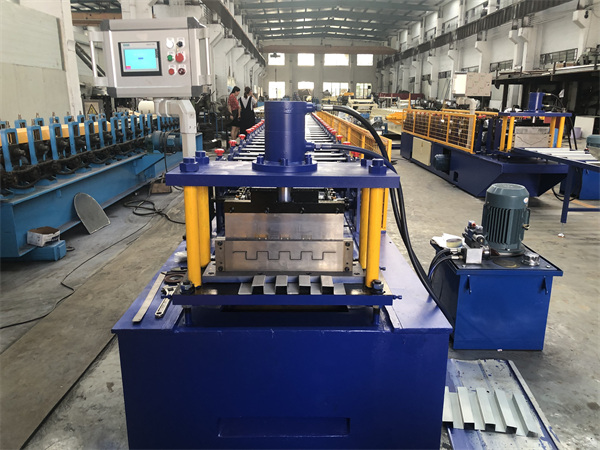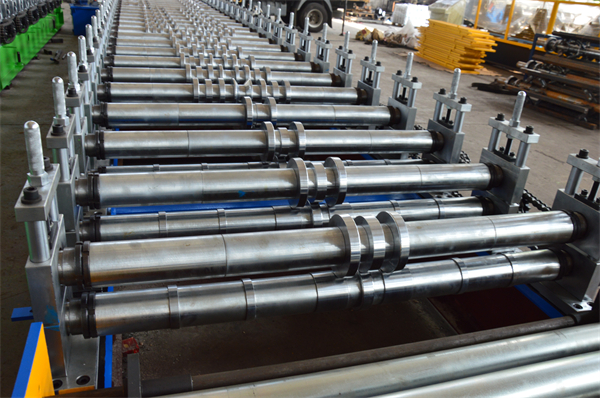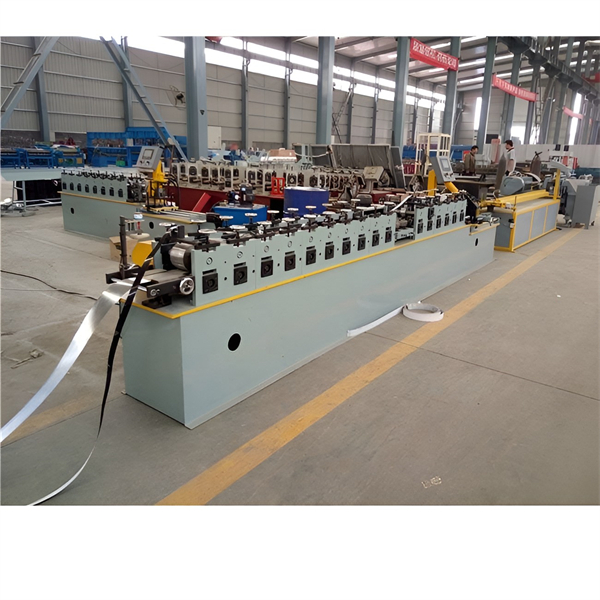Pembentukan gulungan bergelombang adalah proses yang digunakan untuk membentuk lembaran dan profil bergelombang dari gulungan logam datar. Mesin pembuat gulungan bergelombang dirancang khusus untuk produksi lembaran dan panel logam bergelombang dengan kecepatan tinggi dan volume tinggi. Panduan ini memberikan gambaran umum terperinci tentang jenis mesin roll forming bergelombang, komponen utama, prinsip kerja, pertimbangan desain, dan aplikasi.
Gambaran Umum Mesin Roll Forming Bergelombang
Pembentukan gulungan bergelombang adalah operasi pembengkokan kontinu di mana strip panjang lembaran logam datar secara bertahap dibentuk melalui serangkaian dudukan gulungan yang diatur dalam barisan berurutan. Lembaran tersebut melewati beberapa roller dies dan dibentuk menjadi profil bergelombang dengan gelombang atau rusuk yang berurutan di sepanjang panjangnya.
Roll forming memungkinkan produksi lembaran dan panel logam bergelombang yang efisien, berkecepatan tinggi, dan bervolume tinggi dari gulungan lembaran logam. Ini sangat ideal untuk memproduksi atap, pelapis dinding, pembatas jalan raya, saluran drainase, dan banyak aplikasi lain yang membutuhkan stok lembaran logam berbentuk dan bergaris.
Dibandingkan dengan proses pengerolan logam lainnya seperti pembengkokan manual atau pengereman tekan, roll forming lebih cepat dan lebih presisi dengan biaya perkakas yang minimal. Proses ini dapat mengakomodasi berbagai bahan dari baja ringan dan baja tahan karat hingga aluminium. Pengukur yang lebih tebal dan logam berkekuatan tinggi juga dapat dibentuk dengan roll.
Garis pembentuk gulungan bergelombang modern yang cepat, fleksibel, dan otomatis untuk produksi yang hemat biaya. Pembentuk gulungan semi-otomatis dan CNC memungkinkan penyesuaian profil yang cepat. Mesin ini dapat menghasilkan lembaran dengan lebar hingga 10 kaki atau lebih dengan kecepatan lebih dari 100 kaki per menit dengan kontrol proses yang sangat baik.
Komponen Utama dari Corrugated Roll Former
Mesin pembuat gulungan bergelombang yang khas terdiri dari komponen-komponen berikut:
| Komponen | Fungsi |
|---|---|
| Uncoiler / Decoiler | Memasukkan stok gulungan strip datar ke dalam roll former |
| Meja pakan | Mendukung dan memandu strip ke dalam gulungan |
| Membentuk gulungan | Secara bertahap membentuk strip menjadi profil bergelombang |
| Jepit gulungan | Mengontrol aliran strip dan ketegangan punggung |
| Meja lari | Mendukung profil yang terbentuk meninggalkan mesin |
| Cutoff geser | Memotong profil sesuai panjangnya |
| Sistem hidrolik | Menyediakan daya untuk stasiun gulungan dan cutoff |
| Kontrol | Mengoperasikan dan memantau mesin |
Bagian pembentukan kritis memiliki serangkaian stasiun gulungan, masing-masing dengan set gulungan atas dan bawah yang dirancang untuk membentuk logam secara berurutan dengan penambahan kecil. Set gulungan bekerja berpasangan untuk membengkokkan material, dengan gulungan bawah biasanya bertenaga dan gulungan atas mengambang.
Gulungan pemandu, penari telanjang, dan alat lainnya dapat ditambahkan untuk membantu pembengkokan progresif dan membantu lembaran melalui stasiun. Jumlah dan konfigurasi penyangga gulungan tergantung pada bentuk dan kompleksitas profil.

Bagaimana Cara Kerja Mesin Roll Forming Bergelombang?
Pembentukan gulungan bergelombang melibatkan pembentukan kembali strip datar secara terus menerus dan bertahap menjadi profil bergaris menggunakan serangkaian roller dies. Berikut ini adalah gambaran umum dari proses pembentukan:
- Stok gulungan lembaran dimuat pada uncoiler yang mengumpankan strip melalui pelurus awal dan masuk ke bagian pembentukan.
- Strip datar memasuki set pertama gulungan berkontur yang membuat lengkungan kecil pada bahan.
- Sewaktu bergerak melalui setiap dudukan, strip secara berurutan ditekuk sedikit lebih banyak oleh kontur gulungan.
- Secara bertahap, efek kumulatif dari tikungan kecil membentuk strip menjadi profil bergelombang dengan tulang rusuk dan lembah.
- Dudukan roll pinch mengontrol aliran strip dan mempertahankan ketegangan punggung.
- Lembaran yang sudah terbentuk sempurna keluar dari dudukan terakhir dan ditopang pada meja runout.
- Gergaji potong terbang memotong lembaran bergelombang sesuai panjang yang diinginkan untuk digunakan.
- Lembaran-lembaran tersebut dapat ditumpuk secara manual atau otomatis dengan sistem konveyor hilir.
Kuncinya adalah membengkokkan material secara bertahap dalam beberapa langkah tanpa memberikan tekanan yang berlebihan. Kontur gulungan dikerjakan dengan mesin yang presisi untuk membentuk material secara progresif di sepanjang dudukan yang berurutan menjadi profil akhir.
Roll forming memungkinkan produksi lembaran bergelombang secara kontinu dengan kecepatan tinggi hingga 100 kaki/menit atau lebih. Proses ini diotomatisasi untuk pembuatan gulungan-ke-lembaran yang efisien.
Jenis Mesin Roll Forming Bergelombang
Ada beberapa konfigurasi pembentuk gulungan bergelombang untuk menghasilkan profil dan geometri lembaran yang berbeda:
| Jenis Mesin | Keterangan |
|---|---|
| Mesin bergelombang standar | Menghasilkan profil bergelombang dasar untuk atap dan dinding |
| Pembentuk gulungan multi-profil | Gulungan yang dapat dipertukarkan dengan cepat untuk membuat profil yang berbeda |
| Korugator lembaran lebar | Membentuk lembaran dengan lebar lebih dari 5 kaki untuk kontainer pengiriman |
| Korugator bentang panjang | Membuat lembaran bergelombang ekstra panjang hingga 40 kaki |
| Korugator pengukur berat | Membentuk bahan yang lebih tebal lebih dari 0,100 inci |
| Korrugator lapisan ganda | Menciptakan lembaran bergelombang dengan ketebalan ganda |
| Korugator pengumpanan otomatis | Dengan uncoiler dan meja runout yang terintegrasi |
| Bekas gulungan CNC | Parameter pembentukan yang sepenuhnya dapat diprogram |
- Korrugator standar - Mesin yang paling umum dengan set gulungan tetap untuk produksi volume tinggi dari profil atap atau dinding standar. Desain paling sederhana dengan 6-8 dudukan gulungan.
- Pembentuk gulungan multi-profil - Dilengkapi dengan set roll pembentuk perubahan cepat yang dapat diganti untuk menghasilkan profil yang berbeda pada mesin yang sama. Mengurangi biaya perkakas.
- Korrugator lembaran lebar - Mesin khusus yang dirancang untuk produksi lembaran bergelombang lebar bervolume tinggi untuk bangunan pertanian, trailer truk, dll. Lebar lembaran melebihi 5 kaki.
- Bergelombang bentang panjang - Menghasilkan panel bergelombang ekstra panjang dalam satu bagian hingga 40 kaki untuk bangunan dan struktur industri. Memerlukan gulungan penyangga tambahan.
- Korugator pengukur berat - Dengan komponen tugas berat untuk membentuk pengukur material yang lebih tebal dengan ketebalan lebih dari 0,100 inci. Terutama digunakan untuk atap dan dinding struktural.
- Bergelombang lapisan ganda - Menciptakan lembaran bergelombang dengan ketebalan ganda dengan membentuk dua lembar secara bersamaan dan menyatukannya. Digunakan untuk panel berkekuatan tinggi.
- Korugator pengumpanan otomatis - Mengintegrasikan uncoiler dan meja runout untuk aliran material secara otomatis. Mengurangi tenaga kerja dan penanganan.
- Pembentuk gulungan CNC - Mesin yang dapat diprogram sepenuhnya yang dapat menyimpan berbagai profil dan menyesuaikan semua parameter pembentukan melalui konsol kontrol. Paling fleksibel untuk proses produksi rendah hingga menengah.
Spesifikasi Utama dan Pertimbangan Desain
Mesin roll forming bergelombang dirancang dan berukuran berdasarkan lebar lembaran yang diinginkan, ketebalan material, kecepatan jalur, dan volume produksi. Berikut adalah spesifikasi utama yang perlu dipertimbangkan:
Lebar Lembar
- Tersedia mulai dari lebar 1 kaki hingga 10 kaki atau lebih
- Lembaran yang lebih lebar mungkin memerlukan rol penyangga
- Lebar standar adalah 2 kaki atau 4 kaki untuk atap
Ketebalan bahan
- Biasanya 24 GA hingga 18 GA (0,024 "- 0,048")
- Alat pengukur yang lebih berat membutuhkan kapasitas gulungan yang lebih besar
Kecepatan Jalur
- Kecepatan hingga 100 kaki/menit adalah standar
- Kecepatan maksimum tergantung pada ukuran material dan kompleksitas profil
Volume produksi
- Output hingga 10.000 kaki persegi/jam
- Volume yang lebih tinggi membutuhkan kecepatan jalur yang lebih cepat
Bentuk Profil
- Kontur gulungan menentukan bentuk dan ukuran rusuk
- Profil yang lebih kompleks membutuhkan lebih banyak penyangga gulungan
Kapasitas Kumparan
- Hingga 30.000 lb gulungan
- Uncoiler yang lebih besar untuk produksi volume tinggi
Kontrol Panjang
- Geser putar untuk panjang hingga 50 kaki
- Geser potong terbang untuk setiap panjang kosong
Jenis Otomasi
- Kontrol manual vs kontrol PLC yang dapat diprogram
- Pemrograman CNC untuk pergantian cepat
Saat memilih corrugated roll former, faktor-faktor kunci ini menentukan ukuran dan konfigurasi mesin untuk kebutuhan produksi yang diinginkan.
Aplikasi dan Penggunaan Corrugated Roll Forming
Panel yang dibentuk dengan gulungan bergelombang memiliki banyak kegunaan karena kekuatannya yang tinggi, ringan, dan kapasitas bentangnya. Berikut adalah beberapa aplikasi utama:
Atap dan Dinding
- Lembaran bergelombang standar untuk bangunan pertanian dan komersial
- Lebih kuat, lebih ringan, dan lebih cepat dipasang dibandingkan bahan bangunan tradisional
Pembingkaian Struktural
- Sebagai purlins dan girts utama pada rangka bangunan logam
- Mengganti bagian baja struktural yang lebih berat
Pelapis Eksterior
- Penutup dinding dekoratif untuk memberi aksen pada eksterior bangunan
- Tersedia dengan lapisan dan warna khusus
Dinding Interior
- Perakitan cepat struktur berdinding dan partisi
- Tempat penampungan sementara, kamar bersih, dan dinding penahanan
Gorong-gorong dan Drainase
- Pipa logam bergelombang untuk limpasan air hujan
- Pelapis parit dan saluran untuk infrastruktur
Papan Nama dan Tampilan
- Pelat dan permukaan bergelombang yang dekoratif dan menghadap ke dalam
- Tampilan dan rambu-rambu di tempat pembelian
Transportasi
- Panel untuk trailer truk dan kontainer
- Gerbong kereta api dan kontainer antar moda
Pembentukan gulungan bergelombang memungkinkan produksi panel logam bergaris yang efisien, ideal untuk atap, dinding, rangka, dan aplikasi struktural yang membutuhkan kekuatan, kemampuan bentang, dan pemasangan cepat.

Keuntungan dari Pembentukan Gulungan Bergelombang
Dibandingkan dengan proses pembentukan logam lainnya, pembentukan gulungan bergelombang memiliki manfaat sebagai berikut:
- Kecepatan tinggi - Hingga 5 kali lebih cepat dari pembentukan rem
- Volume tinggi - Untuk produksi massal dan proses produksi yang panjang
- Ketepatan dimensi - Mempertahankan geometri profil yang akurat
- Penghematan material - Penggunaan bahan baku kumparan yang efisien
- Penghematan tenaga kerja - Proses otomatis membutuhkan lebih sedikit pekerja
- Biaya perkakas rendah - Roll set sederhana dan murah
- Fleksibilitas - Pergantian cepat ke profil baru
- Fleksibilitas material - Bentuk berbagai macam logam dan alat pengukur
- Kekuatan - Pengerasan kerja meningkatkan kekuatan lembaran
- Struktur yang lebih ringan - Mengurangi biaya transportasi dan pemasangan
- Kualitas yang konsisten - Proses pembentukan yang dapat diulang
Dengan membentuk ulang material secara bertahap dalam jumlah kecil, roll forming menghindari tekanan berlebih yang terlokalisasi atau sobekan yang umum terjadi pada metode pembengkokan lainnya. Prosesnya cepat, efisien, dan ideal untuk produksi massal lembaran dan panel logam bergelombang.
Keterbatasan Proses Pembentukan Gulungan Bergelombang
Terlepas dari kelebihannya, pembentukan gulungan bergelombang memiliki beberapa keterbatasan yang perlu dipertimbangkan:
- Biaya penyiapan awal - Mesin memiliki biaya modal awal yang lebih tinggi
- Profil tetap - Mengubah profil memerlukan perubahan gulungan
- Panjang garis - Alat berat yang panjang membutuhkan ruang yang besar
- Batas lebar lembar - Lebar maksimum tergantung pada kapasitas mesin
- Batas panjang lembaran - Tergantung pada tabel dukungan keluar
- Ketebalan lembaran - Terbatas untuk logam pengukur yang lebih tipis
- Operasi sekunder - Mungkin perlu pembengkokan atau pemotongan tambahan
- Batasan profil - Tidak dapat menghasilkan manik-manik atau emboss yang rumit
Proses ini paling hemat biaya untuk produksi volume tinggi. Roll set memiliki profil yang spesifik dan tidak mudah diubah. Lebar dan ketebalan lembaran maksimum dibatasi oleh kapasitas garis pembentuk gulungan. Operasi sekunder mungkin masih diperlukan setelah pengerolan awal.
Memilih Pemasok Mesin Roll Forming Bergelombang
Saat berinvestasi dalam sistem pembentukan gulungan bergelombang baru, faktor kunci dalam memilih pemasok meliputi:
| Pertimbangan | Kriteria Evaluasi |
|---|---|
| Reputasi | Pengalaman industri, ulasan pelanggan |
| Desain Gulungan | Keahlian teknik internal |
| Manufaktur | Kontrol kualitas dan kapasitas produksi |
| Kustomisasi | Kemampuan untuk mengakomodasi kebutuhan khusus |
| Persediaan | Ketersediaan cepat ukuran mesin yang umum |
| Dukungan | Bantuan pemasangan dan pelatihan operator |
| Melayani | Waktu respons pemeliharaan dan dukungan |
| Harga | Perbandingan total biaya opsi |
- Reputasi - Perusahaan yang sudah mapan dengan pengalaman industri yang telah terbukti secara konsisten memproduksi peralatan berkualitas tinggi. Periksa testimoni pelanggan.
- Desain gulungan - Pemasok harus memiliki keahlian teknik internal untuk merancang perkakas roll untuk berbagai profil dan spesifikasi.
- Manufaktur - Carilah manufaktur modern dengan pengujian kontrol kualitas selama produksi. Diutamakan kapasitas produksi yang tinggi.
- Kustomisasi - Pemasok harus mengakomodasi persyaratan lembaran non-standar dan menyediakan solusi roll forming yang disesuaikan.
- Persediaan - Ukuran mesin umum yang tersedia dengan cepat mengurangi waktu tunggu. Mesin khusus membutuhkan waktu 1-3 bulan.
- Dukungan - Bantuan instalasi dan pelatihan operator menambah nilai tambah.
- Melayani - Perputaran yang cepat untuk dukungan teknis, pemeliharaan, dan suku cadang.
- Harga - Bandingkan total biaya kepemilikan selama masa pakai. Pertimbangkan kapasitas produksi, keandalan, dan pemeliharaan.
Memilih produsen peralatan roll forming bergelombang yang berpengalaman memastikan kinerja tinggi, pengiriman cepat, dan dukungan berkelanjutan.
Instalasi dan Pengoperasian
Prosedur pemasangan dan pengoperasian yang tepat sangat penting untuk kinerja optimal dari sistem pembentukan gulungan bergelombang. Berikut adalah beberapa panduan utama:
Instalasi
- Sediakan ruang yang cukup untuk bongkar muat gulungan dan lembaran yang aman
- Pasang di lantai beton yang datar dan rata untuk meminimalkan getaran
- Jangkar mesin dengan aman ke pondasi
- Hubungkan catu daya listrik sesuai peringkat yang ditentukan
- Pasang semua pelindung dan pengaman sebelum pengoperasian
- Memastikan pengardean yang benar ke bumi
Pengaturan
- Pasang set gulungan yang benar untuk profil yang diinginkan
- Memeriksa pengaturan dan penyelarasan gulungan
- Masukkan lembar percontohan melalui mesin secara bertahap
- Mengatur ketegangan gulungan jepit dan posisi geser
- Parameter kontrol program dan siklus pengujian
Operasi
- Kenakan APD yang tepat - kacamata pengaman, sarung tangan, sepatu bot berujung baja
- Pastikan hanya pekerja terlatih yang mengoperasikan peralatan
- Ikuti petunjuk pengoperasian dari pabrik pembuatnya
- Mempertahankan aliran dan tegangan strip yang stabil
- Monitor untuk pelacakan strip dan getaran
- Melakukan uji coba sebelum produksi
- Tingkatkan kecepatan secara bertahap selama periode pembobolan
- Pastikan pelumasan yang memadai selama berlari
- Berhati-hatilah di sekitar bagian yang berputar dan bukaan gulung
- Jaga agar area geser tetap bersih saat memotong lembaran
- Tumpuk lembaran yang sudah jadi dengan hati-hati atau bawa ke hilir
Prosedur pemasangan, penyetelan, dan pengoperasian yang tepat akan memaksimalkan kinerja dan keamanan corrugator. Personel harus dilatih sepenuhnya untuk menghindari kesalahan yang menyebabkan kerusakan pada dudukan. Bacalah panduan dari produsen untuk petunjuk operasional yang spesifik.
Pemeliharaan dan Pemecahan Masalah
Program perawatan yang komprehensif sangat penting untuk meminimalkan waktu henti dan memastikan kualitas yang konsisten untuk lini roll forming bergelombang.
Perawatan Pencegahan
- Pembersihan dan inspeksi harian
- Memeriksa kesejajaran gulungan dan pelacakan strip
- Pastikan pelumasan yang tepat pada semua bagian yang bergerak
- Kencangkan pengencang yang longgar
- Menguji sistem hidraulik dari kebocoran
- Memeriksa lasan dan sambungan struktural
- Pastikan sambungan listrik sudah kencang
Pemeliharaan Kerusakan
- Mendiagnosis dan memperbaiki masalah dengan segera untuk meminimalkan waktu henti
- Baca panduan pemecahan masalah untuk mengidentifikasi masalah
- Memperbaiki kerusakan atau ketidaksejajaran gulungan sebelum terjadi kerusakan besar
- Segera ganti bantalan rol/segel yang aus
- Memperbaiki kebocoran pada hidrolika dan memperbarui sistem oli
- Mengatasi komponen mesin yang longgar atau aus
- Memperbarui komponen dan kontrol elektronik yang sudah usang
Perbaikan
- Jadwalkan perbaikan besar secara berkala untuk masa pakai yang lebih lama
- Mengatur kembali gulungan pembentuk ke kontur presisi asli
- Mengganti pompa, motor, dan silinder hidraulik
- Tingkatkan sistem kontrol dan komponen listrik
Pemeliharaan proaktif dan perbaikan cepat mengurangi pemadaman yang tidak direncanakan. Bermitra dengan OEM dapat memberikan keahlian pemecahan masalah yang berharga dan akses inventaris suku cadang.

FAQ
T: Ketebalan lembaran logam apa yang dapat dibentuk gulungan?
J: Pembentuk gulungan bergelombang standar dapat membentuk ketebalan lembaran dari 24 gauge hingga 16 gauge (0,024 "- 0,060"). Mesin pengukur yang lebih berat tersedia untuk ketebalan yang melebihi 0,100 ".
T: Berapa lebar lembaran maksimum untuk pembentukan gulungan bergelombang?
J: Kebanyakan mesin bergelombang atap standar mengakomodasi lebar lembaran hingga 5 kaki. Mesin bergelombang yang lebih lebar dapat menghasilkan lembaran dengan lebar lebih dari 10 kaki untuk panel pelapis dinding.
T: Berapa lama lembaran bergelombang diproduksi?
J: Panjang lembaran ditentukan oleh geseran cutoff terbang dan ukuran meja runout. Panjang tipikal hingga 30 kaki adalah standar. Corrugator bentang panjang dapat membuat lembaran dengan panjang lebih dari 40 kaki.
T: Jenis logam apa yang dapat digulung menjadi lembaran bergelombang?
J: Pembentukan gulungan bergelombang berfungsi untuk baja karbon rendah, baja tahan karat, aluminium, dan paduan tembaga. Gulungan yang sudah dicat dan digalvanis juga dibentuk untuk menghasilkan lembaran jadi.
T: Apa yang menentukan bentuk profil dan dimensi rusuk?
J: Profil kontur yang dikerjakan pada gulungan menentukan bentuk rusuk, tinggi, pitch, dan dimensi yang tepat yang terbentuk pada lembaran. Gulungan memiliki profil yang spesifik.
T: Berapa lama waktu yang diperlukan untuk mengganti ke profil baru?
J: Pada mesin manual, pergantian roll membutuhkan waktu 2-4 jam. Pada mesin CNC dengan set roll ganti cepat, perubahan profil dapat dilakukan dalam waktu kurang dari satu jam.
